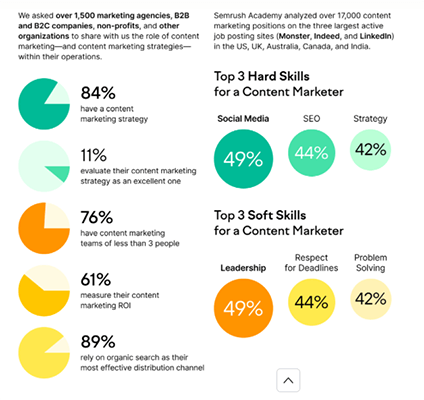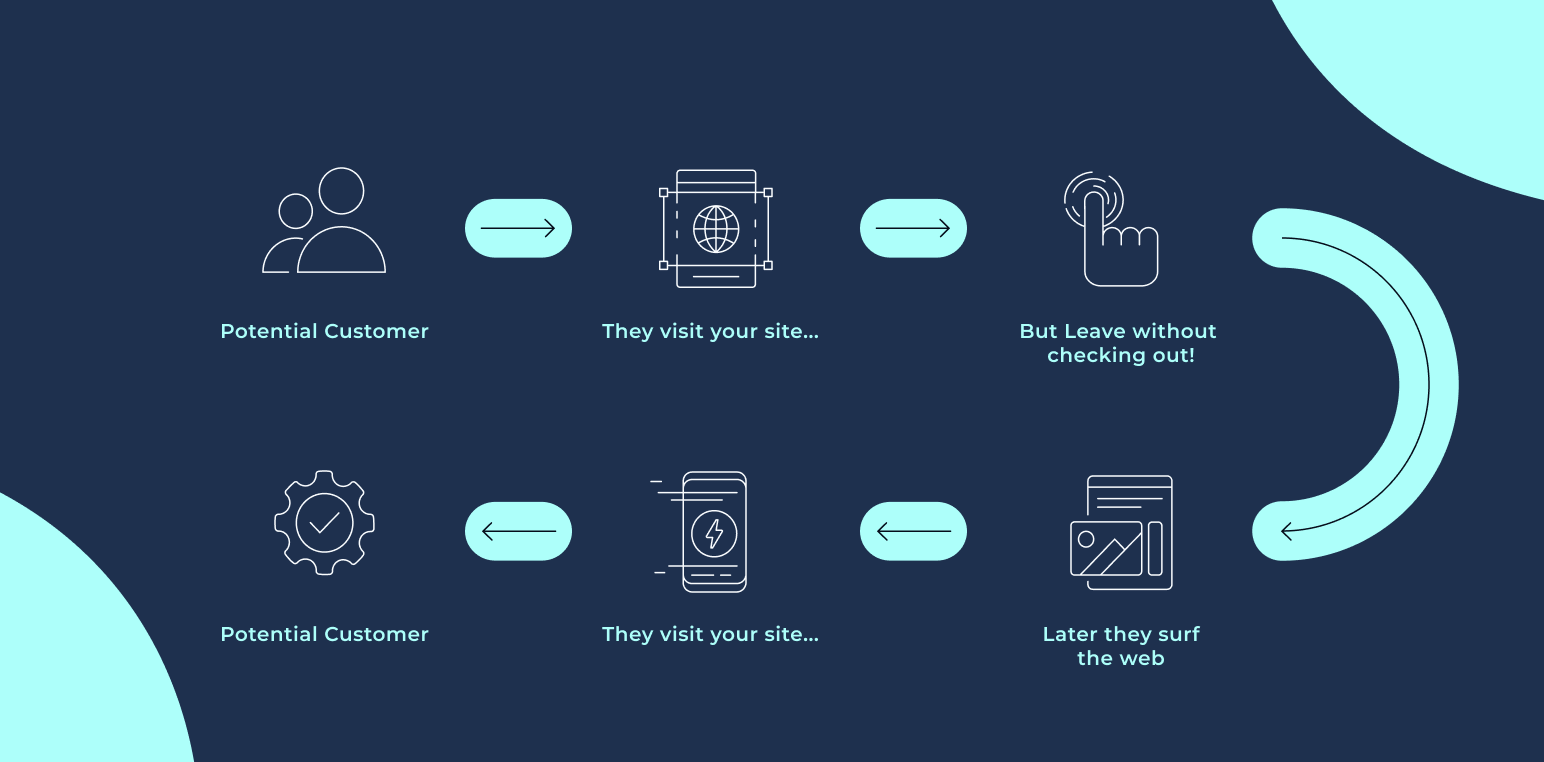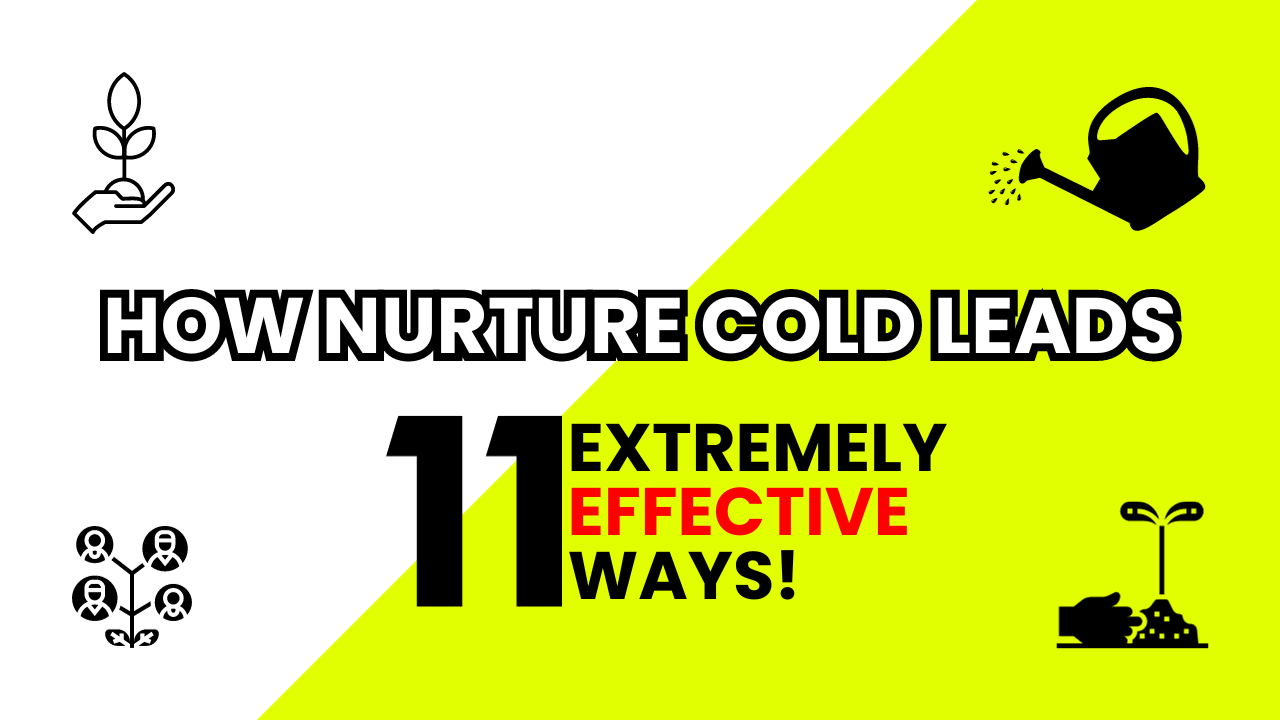You’re sitting there with a list of cold leads, and the big question is hanging in the air: “What now?”
Well, consider that question answered.
This isn’t just a list, it’s a ‘Lead Nurturing’ battle plan.
We’re diving into 11 powerful, no-fuss strategies that are your secret weapon for turning those lukewarm names into hot prospects who are as engaged as they are ready to sign on the dotted line.
We’re talking real, down-to-earth tactics – the kind that slice through the sales noise and get you results.
No complicated jargon, no roundabout methods, just a straightforward, step-by-step playbook that takes those cold leads and warms them up to your business, transforming them into solid, profitable customer relationships.
After reading this guide, you’ll never find yourself thinking about ‘how to nurture cold leads’ ever again.
So, are you ready to turn that list of maybes into a bunch of for-sures?
Let’s dive into these 11 extremely effective ways to nurture cold leads and get them warmed up and ready to grow with you.
Summary
In the next few scrolls, you’ll unlock the secrets to turning indifferent prospects into loyal customers.
Get ready to learn how to:
– craft messages that resonate,
– create connections that count,
– and use strategies that have proven their worth in the real-world marketplace.
From personalized sales emails that catch their eye to smart social media marketing moves that engage, we’ll cover the full spectrum of techniques that warm up even the coldest of leads.
No matter your industry or the size of your business, these insights are about to change your lead nurturing game.
Keep reading, because this is where ‘potential’ meets ‘actual sales’.
What is considered as a Cold Lead?
A cold lead is like a stranger you’ve just met: they know your name, maybe a few basic facts, but that’s about it.
In sales terms, a cold lead is someone who’s had a glimpse of your product or service but hasn’t shown an active interest yet.
They could have signed up for your company newsletter, visited your website, or clicked on an ad by chance.
They’re not against chatting with you, but they’re not waiting by the phone either.
These leads haven’t warmed up to your business, and it’s your job to convert that initial curiosity into a real conversation.
What is considered as a Hot Lead?
A hot lead is like a guest at a dinner party who’s already raving about the appetizers.
They know what you’re offering and they’re excited about it.
In the world of sales, a hot lead is someone who’s shown a clear interest in your product or service and is just a step away from making a purchase.
They’ve probably interacted with your content multiple times on various marketing channels, asked questions, or maybe they’ve even got their wallet half out, figuratively speaking.
Think of them as someone at the edge of their seat during a thrilling movie – they’re captivated and eager to see what happens next.
That eagerness is what sets them apart from the cold leads.
They’re warm, almost hot, to the idea of buying from you, making them prime candidates for your focused sales efforts.
Is there a difference between nurturing strategies for them?
Of course, there’s a big difference between how you nurture cold leads and hot leads.
Think about it like this: if someone is just learning about what you sell, you wouldn’t talk to them the same way you would with someone ready to buy, right?
With cold leads, your job is to gently guide them, to show them why what you’re selling (products or services) is worth a look, and worth their time.
You have to be patient, share helpful info, and build trust slowly.
But with hot leads, they’re already interested, so you focus more on answering their questions, giving them the details they need, and helping them make that final decision to buy.
The key is to match your approach with where they are on their sales journey from maybe to yes.
Understanding this difference is crucial because it shapes how you communicate with each type of lead.
And that brings us to the practical part: the actual strategies you can use to nurture cold leads effectively in 2023, which we’ll dive into next.
How To Nurture Cold Leads?
Now, onto the heart of the matter: how to nurture cold leads in 2023.
It’s about smart steps and steady efforts to show these potential customers why your business stands out.
We’ll break down lead nurturing each strategy, showing you exactly how to create that spark of interest and fan it into a flame.
Think clear-cut advice, actionable tips, and the kind of guidance that can turn the chilliest of contacts into your next success story.
Let’s roll up our sleeves and get to work.
Strategy #1 Educational Content

When you’re dealing with cold leads, think of educational content as your initial handshake.
It’s your chance to introduce them to your brand without coming on too strong.
This approach is brilliant because it offers value upfront, without demanding anything in return just yet.
So why does educational content work so well?
It’s all about building trust.
When you share your knowledge freely, you’re not just another company trying to make a quick sale.
You become a reliable source of information.
This builds credibility and positions you as an authority in your field.
How should you use it?
Start with the issues and questions that your potential customers and prospects are already pondering.
Create blog posts, videos, infographics, or even podcasts that answer these questions.
The key is to keep the content relevant and engaging – no heavy sales pitches here. Your aim is to be helpful.
As for when to use educational content, it’s pretty much always a good time.
It’s especially effective early in the relationship when you’re just starting to warm up those cold leads.
Make sure that the content is easy to consume and share. Accessibility is the name of the game.
Now, for some quick tips:
1. Keep it simple: No jargon or complex language.
2. Be consistent: Regularly release new content to keep leads coming back for more.
3. Focus on their needs, not your product: Help them solve a problem or learn something new.
4. Encourage interaction: Ask questions or include calls-to-action that get leads thinking and responding.
By educating your leads, you’re not only nurturing a potential customer, but you’re also laying down the groundwork for a relationship based on trust and expertise.
It’s a long-game strategy that pays off in customer loyalty and engagement.
Sharing this top-notch educational content has a compounding effect.
As you consistently provide value, not only do you build rapport with the cold leads you have, but you also enhance your personal brand.
This boost in your reputation doesn’t go unnoticed.
As you become known for helpful guides, insightful articles, and useful tips, word spreads.
Your name becomes synonymous with trustworthiness and expertise, leading people to share your content with others who have similar questions or needs, thus expanding your reach organically.
And just like that, those who’ve benefited from your content become new leads, drawn in by the credibility of your brand’s knowledge.
So, every educational piece you share does double duty: nurturing current cold leads while simultaneously attracting new ones.

It’s a virtuous cycle that can significantly amplify your lead generation efforts, continuously bringing more potential customers into the fold.
Strategy #2 Personalized Email Campaigns
Personalized email campaigns are a direct line to your cold leads’ inboxes, offering a prime opportunity to nurture a connection.
These aren’t your standard, spray-and-pray marketing/sales emails.
We’re talking about tailored marketing messages that resonate on a personal level.
Personalization means you recognize your leads as individuals with unique needs and preferences.
Why go personalized?
Because it feels like a one-on-one conversation.
People are more likely to engage with an email that speaks to their specific situation.
And when someone feels understood, they’re more open to what you have to say.
How to execute this?
Dig into the data.
Use what you know about your leads to create messages that matter to them.
– Did they download a particular resource? Reference that in your email.
– Do they work in a specific industry? Mention how your solution fits into their world.
Timing is also vital.
You want to catch them when they’re most receptive.
For some, that might be after they’ve interacted with your company website.
For others, it could be triggered by an event relevant to their business. Pay attention to these cues.
Here are a few strategies and tips to get you started:
1. Segment your email list: Not all cold leads are the same. Group them by behavior, demographics, or stage in the sales funnel.
2. Automate but keep it personal: Use email automation tools to send marketing emails at scale, but always include elements of personalization.
3. A/B testing: Try different subject lines and email content to see what works best and refine your approach.
4. Follow-up: If they open an email but don’t take action, send a follow-up. Sometimes, all it takes is a little nudge.
And don’t forget the benefits.
With personalized email campaigns, you’re likely to see higher open rates, more engagements, and ultimately, a stronger relationship with your sales leads.
It’s about showing them that you see them as more than just a name on a list.
When you get it right, personalized emails can make a lead feel like you’re speaking directly to them, creating a connection that’s hard to ignore.
This strategy is more than just a way to increase sales, it’s about establishing a rapport.
As you fine-tune this approach and consistently send out messages that hit the mark, you also solidify your reputation as a business that listens and adapts to its prospects.
And as your personal brand strength grows, you may find that your cold leads start to warm up not just to your emails, but to your entire suite of offerings.
Strategy #3 Retargeting Campaigns

Retargeting campaigns are a powerful tool to re-engage cold leads who have shown interest in your product or service but haven’t taken the plunge.
These marketing campaigns work by serving targeted ads to individuals who have visited your website or engaged with your brand, reminding them of what they’ve seen and encouraging them to take another look.
Here’s why retargeting is so effective: it keeps your brand top-of-mind.
People are busy, they get distracted and might not remember to return to your site after the first visit. Retargeting is a gentle tap on the shoulder saying, “Hey, remember us?”
To implement a retargeting campaign effectively, you need to:
1. Set clear objectives: Know what action you want your leads to take. Is it to download a white paper (or other resources), sign up for a webinar, or make a purchase?
2. Segment your audience: Tailor your ads according to the specific pages leads visited on your site to make your retargeting efforts more relevant.
3. Choose the right platform: Whether it’s Facebook, Google, LinkedIn, X or another channel, pick where your leads spend the most time.
4. Craft compelling ad copy: The message should be clear, engaging, and aligned with where the lead is in the sales process.
The timing aspect is also very important.
You don’t want to bombard recent visitors with ads immediately, give them a moment to breathe and try to strike a balance between being present and being pushy.
Here are some benefits of retargeting campaigns:
- Increased brand recognition: You’ve probably heard about the rule of 7 so the more your leads see your brand, the more familiar and trustworthy it becomes.
- Higher conversion rates: Retargeting can bring back indecisive prospect and encourage them to complete a purchase.
- Better ROI: Since you’re targeting people who have already shown interest, retargeting often yields a higher return on investment than other advertising methods.
Retargeting campaigns are a smart move because they leverage existing prospect interests.
Rather than casting a wide marketing net, you’re focusing on individuals who are already halfway through the door.
It’s a targeted approach that, when done well, subtly convinces the lead that your product or service is worth another glance.
And as these marketing leads circle back to you, thanks to the reminders they’ve seen, they’re more likely to transition from cold to warm, getting ever closer to making a decision in your favor.
Strategy #4 Social Media

Social media is an essential strategy for nurturing cold leads as it allows you to participate in conversations that resonate with your audience.
‘Alright, but why does this work so well?’
Social media platforms are where people hang out, express their opinions, and seek information.
So, by engaging with users on these platforms, you’re meeting leads where they’re most comfortable. You can’t meet them on places (or in this case channels) where they are not, or where they aren’t in the right ‘mood’ to engage with you, right?
So this is a casual yet effective way to introduce your brand and build a rapport.
To get social media engagement right, consider these points:
1. Know your platforms: Different social media channels attract different demographics. Be strategic about where you post.
2. Create shareable content: The more your content is shared, the wider your reach.
3. Engage genuinely: Respond to comments, messages, and reviews to show that you value feedback and dialogue.
4. Monitor conversations: Keep an eye on what’s being said about your brand and your industry. This can provide insights into how to approach your audience.
The timing of engagement is also key.
You want to be active during the times your leads are most likely to be online and interacting with content.
Use analytics tools to determine these peak times and schedule your activity accordingly.
Benefits of social media engagement include:
- Enhanced brand visibility: Regular interaction increases your visibility on these platforms.
- Audience insights: Engaging with your audience can give you valuable insights into their needs and preferences.
- Relationship building: By consistently engaging, you’re likely to create stronger connections with potential customers.
Social media engagement turns the abstract concept of a company into a tangible, approachable entity.
When cold leads see your brand actively interacting and contributing to the community, they start to see you as an ally, not just a business.
This familiarity breeds trust, and trust is the key to converting a cold lead into an interested prospect.
As you converse, share, and respond, you’re not just nurturing leads, you’re cultivating a community that believes in your brand.
Strategy #5 Networking at Events
Networking at events is as classic as it gets, yet it remains one of the most effective ways to nurture cold leads.
It’s the personal touch that no digital wizardry can quite replicate.
Why does this sales tactic stand the test of time?
Because business, at its core, is about human connection.
Events give you the platform to turn a handshake into a conversation, a business card into a follow-up email, and an introduction into a long-term business relationship.
Here’s how to make networking at events work for you:
1. Choose wisely: Select events that are likely to be frequented by your target audience.
2. Be prepared: Have your elevator pitch ready, but also be ready to listen.
3. Make genuine connections: Go beyond small talk. Find common ground that can lead to deeper discussions.
4. Follow-up: This is crucial. After the event, reach out with a personalized message referencing your conversation.
When it comes to the question of timing, earlier is usually better. Warm up to your cold leads by engaging them in light, relevant conversation before diving into business. The trick is to nurture a connection before you need it.
The benefits of networking at events are manifold:
- Immediate feedback: You can gauge reactions to your pitch or ideas on the spot.
- Memorable interactions: Face-to-face meetings are often more memorable than digital ones.
- Potential partnerships: You might find opportunities for collaborations or joint ventures.
Networking at events injects a human element into the sometimes faceless process of lead nurturing.
By interacting in a shared space, you not only put a face to your brand but also build the foundations of trust.
And in a world that’s increasingly virtual, the impact of a physical presence and a solid handshake can set you apart, transforming cold leads into warm prospects ready for the next step.
Strategy #6 Interactive Tools
Interactive tools are the secret sauce to engagement in the digital realm. They turn passive browsing into active participation, and for cold leads, that’s a golden ticket to heightened interest and engagement.
Why are interactive tools so compelling?
They require input from the user, which means immediate investment in the process.
Whether it’s a calculator, a quiz, or a configurator, interactive tools have the user doing something, which psychologically makes them more involved and more likely to remember your brand.
Here’s how to wield interactive tools effectively:
1. Match the tool to the lead: Ensure the tool you choose is relevant to their needs and interests.
2. Simplicity is key: Make sure the tool is easy to use and understand, or you risk losing their interest.
3. Educate as they engage: Provide valuable information or insights as part of the interaction.
4. Capture data wisely: Use the tool to gather information about the lead, but always with their consent.
When it comes to timing, Introduce them at a point where engagement naturally dips to reinvigorate interest. Early in the lead nurturing process is ideal, as it can help transition a cold lead to a warm one with just a few clicks.
The benefits of employing interactive tools are clear:
- Enhanced engagement: A sales lead who interacts with your tools is more engaged than one who passively reads content.
- Valuable insights: The data gathered can offer deep insights into your leads’ preferences and behaviors.
- Better qualification: Sales leads who use your tools are often further along in the buying process and can be more easily qualified.
Interactive tools are not just flashy gadgets, they’re an effective bridge between the unknown and the engaged.
They create a micro-commitment, a small step that leads can take towards your brand, making them a potent weapon in the arsenal for nurturing cold leads.
Strategy #7 Free Trials or Demos

Consider free trials or demos as the tasting spoons of the business world; they give a flavor of the full experience without the commitment of a purchase.
This marketing & sales strategy is dynamite for cold leads because it lowers the barriers to entry and mitigates the risk of trying something new. In 2023, this approach is crucial for generation of genuine interest.
Why do free trials or demos work like a charm?
They play into the psychology of ‘try before you buy’, appealing to the human penchant for experiencing something firsthand.
When you offer a snippet of your service or product for free, it demonstrates confidence in what you’re offering and opens the door for leads to experience the value themselves.
Here’s the strategy to maximize the impact of free trials or demos:
1. Make it accessible: Ensure signing up is a breeze and that the trial or demo doesn’t require too many hoops to jump through.
2. Highlight the benefits: Clearly showcase what your prospect will gain from this trial or demo, effectively generating interest and anticipation.
3. Time it right: Offer these free experiences just when a prospect is looking for solutions to their problems, making your team’s efforts more fruitful.
4. Follow up: Use the opportunity to gather feedback and guide the sales lead through the next steps post-trial, aiming to convert their interest into a commitment.
When to drop the free trial or demo card?
Introduce it at a strategic moment, perhaps after a sales lead has interacted with your blog or has been educated about your product.
It’s like saying, “You’ve read about how this works, now see for yourself!”
And the benefits are a no-brainer:
- Direct experience: Leads get to experience your products or services directly, which can be far more convincing than any marketing material.
- Engagement: Trials or demos require active participation, keeping your leads engaged with your brand.
- Feedback opportunity: The insights you gain from user experience during the trial period are gold for improving your offering and fueling lead generation.
By implementing free trials or demos, you’re not just giving a sneak peek of your product, you’re actively investing in the relationship with potential customers.
This shows that you’re serious about delivering value, and that confidence can be infectious.
Finally, as leads get a taste of your solution’s potential impact on their lives or businesses, the leap from a cold lead to a customer becomes shorter.
A free trial or demo is more than just a strategy, it’s a conversion catalyst, turning skepticism into trust, and trust into action, a fundamental method to generate lasting customer relationships.
Strategy #8 Surveys and Feedback Requests
Engaging cold leads can often be a matter of asking the right questions, and that’s where surveys and feedback requests swing into action.
This approach is like the reconnaissance of lead nurturing, it’s less about direct selling and more about learning and listening.
Surveys and feedback requests are fantastic because they serve a dual purpose:
– they signal to leads that you value their opinion
– and they provide you with insights into your audience’s needs and preferences.
How should you incorporate this strategy?
Craft surveys that are concise and purpose-driven.
Ask for feedback that can guide your business decisions – whether it’s about improving product features, tailoring content, or refining your customer service approach.
Here are a few pointers to keep in mind:
1. Make it easy: Use simple, straightforward questions that require minimal effort to answer.
2. Be strategic: Place these surveys where they are most likely to be seen and filled out, like after a blog post or in an email.
3. Offer incentives: Sometimes, a little encouragement in the form of a discount or entry into a giveaway can boost participation rates.
4. Act on the data: Show that the feedback has been heard by making changes and communicating them back to your leads.
‘When’ you deply for surveys and feedback requests is very important. You want to deploy them after a lead has engaged with your content or service to ensure that their experience is fresh in their mind.
Let’s talk benefits:
- Engagement: A well-timed survey can re-engage a lead who might have otherwise remained passive.
- Customization: Feedback allows you to tailor your follow-ups with a personal touch, showing leads that you’ve paid attention to their needs.
- Improvement: Use the feedback to refine your approach, which can, in turn, increase the efficacy of your lead nurturing strategies.
By implementing surveys and feedback requests, you’re sending a message that each lead’s opinion can steer the ship.
This participatory tactic not only enriches your understanding of your audience but can also transform passive observers into active contributors.
When cold leads see that you’re implementing their feedback, it creates a sense of partnership and investment in the success of your offerings.
In essence, you’re turning the feedback loop into a launch pad for long-term engagement and eventual conversion.
Strategy #9 Special Offers and Incentives
Special offers and incentives are like the seasoning in the lead nurturing recipe – they should be used judiciously to enhance, not overwhelm.
The trick is to strike a balance that creates urgency without coming across as desperate or pushy.
This marketing strategy is effective because it taps into a fundamental human trigger: the love of a good deal.
However, if you overuse this tactic in lead generation, you risk diluting its impact.
The offers can become background noise, losing their appeal.
So when and how should your team sprinkle in these offers?
Use them to reward engagement or to re-engage leads who’ve cooled off.
Examples include:
- A time-sensitive discount on a first purchase, a tactic your marketing team can implement effectively.
- Access to exclusive content or resources for a limited number, which can generate additional interest.
- A complimentary upgrade with a first-time subscription, showing the value your team brings to the table.
Here’s what to keep in mind:
1. Timing is everything: Launch these offers occasionally to maintain their special ‘event’ status.
2. Keep it clear: Present the offer simply. What is the deal? How does it benefit them? How can they get it?
3. Show the value: Make sure the lead sees the advantage of taking up the offer now rather than later.
By using special offers and incentives wisely, you can generate compelling touchpoints that nudge cold leads closer to the warmth of a closed deal.
Just remember, if you hand out these golden tickets too freely, they lose their luster.
Use them sparingly, and they’ll remain as enticing as they’re meant to be, leveraging your available marketing resources effectively.
Strategy #10 Customer Testimonials and Case Studies

In the gallery of techniques to nurture cold leads, customer testimonials and case studies are the portraits of real-life success.
They’re potent because they’re not just promises, they’re proof.
And in a world where consumers are bombarded with claims, proof speaks volumes.
Customer testimonials are the applause of satisfied clients, echoing in the ears of your prospects.
They serve as social proof, an influential factor in buying decisions.
When prospects see others praising your products or services, it reduces their uncertainty and builds confidence in your brand.
Case studies go a step further.
They’re the success stories detailed, outlining how real customers solved real problems with your help.
They dig into the ‘before’ and ‘after’, painting a picture of the transformation that occurred thanks to you..
This is storytelling with a purpose.
Here’s how to use them effectively:
1. Be selective: Choose testimonials and case studies that reflect a range of problems and solutions. Diversity in your examples will resonate with a broader audience.
2. Focus on the journey: Highlight the customer’s initial challenge, the solution you provided, and the tangible results they saw.
3. Make it relatable: Use language that feels personal and accessible, not like a technical manual. This is about human experiences, not just features and benefits.
4. Keep it real: Authenticity is key. Prospects can spot a fake a mile away, so ensure all testimonials and case studies are genuine and verifiable.
Employing customer testimonials and case studies in your nurturing strategy does more than just showcase past victories. It underlines the potential for new ones.
When cold leads see the triumphs of others, they start to envision their own success with your services or products.
It’s not about tooting your own horn, it’s about showing that the path they’re considering is well-trodden and leads to a desirable destination.
These narratives, rich with relatable details and real outcomes, don’t just tell what you do – they show it.
And in the world of lead nurturing, showing is always more compelling than telling.
Strategy #11 Follow-up Calls
Follow-up calls might seem old-school, but in the digital age, their impact is more significant than ever. They add a personal touch to your approach, making cold leads feel valued and heard. This strategy is about making a connection, not just a sales pitch.
The power of a follow-up call lies in its directness.
You’re not just another email in an inbox; you’re a voice on the other end of the line, ready to engage in real-time conversation.
This human element can bridge gaps that digital communication often leaves open.
Here’s how to make the most of follow-up calls:
1. Be prepared: Know the lead’s background and previous interactions with your brand. Tailor your call to address their specific interests or concerns.
2. Timing is key: Choose a time for the call that’s likely to be convenient for them, perhaps hinted at in previous interactions.
3. Listen more than you talk: The goal is to understand their needs better and address any hesitations they might have.
4. Keep it brief and focused: Respect their time. A concise, purposeful call is often more effective than a lengthy one.
Follow-up calls are especially useful after a lead has shown some level of engagement, like downloading a resource or attending a webinar. This implies they have some interest and are more likely to be receptive to a call.
Benefits of follow-up calls include:
- Immediate interaction: You can address questions or concerns on the spot, reducing the time it takes to move a lead through the sales funnel.
- Personal connection: A call can establish a rapport that’s hard to achieve via email or social media.
- Feedback opportunity: Direct conversation allows for immediate feedback, which can be invaluable in tailoring your approach to each lead.
In a world where automation and faceless communication are becoming the norm, a follow-up call is a breath of fresh air.
It shows that you’re willing to invest time in your leads, and in turn, they might be more willing to invest in your business.
It’s a strategy that combines the best of both worlds – the personal touch of traditional sales with the insights and efficiency of modern lead nurturing techniques.
How can ZeroIn help you reach your sales targets?
ZeroIn is tailored for those who understand the value of nurturing cold leads but need the right tools to do it effectively. As a business email finder and data export tool for LinkedIn, ZeroIn stands out in its ability to streamline and enhance your lead nurturing process.
Firstly, ZeroIn provides clean, verified, and actionable data.
This means you’re not wasting time chasing leads with outdated or incorrect contact information.
With access to comprehensive data directly from LinkedIn, enriched with real-time verified business emails, your sales outreach becomes more efficient and effective.
The tool’s alignment with GDPR is crucial in today’s landscape of data privacy concerns.
Using ZeroIn assures you that the data you’re collecting is both ethical and compliant, giving you peace of mind and credibility in your outreach efforts.
Accuracy is vital in lead nurturing, and with a 98% accuracy rate, ZeroIn ensures that the information you receive is dependable.
This reliability is crucial when personalizing your approach – a key strategy in generating and warming up cold leads.
ZeroIn also provides an extensive range of data points – 25, to be precise.
This depth of information gives you a multi-dimensional view of your prospects, allowing for a more targeted and personalized approach.
Whether you’re crafting personalized emails, tailoring content for social media engagement, or preparing for follow-up calls, having detailed insights about your leads can make a significant difference.
Lastly, the large database of over 200 million contacts that ZeroIn offers means you’re not limited in your reach. It opens up a world of possibilities for finding the ideal leads, crucial for businesses looking to scale their outreach and improve sales figures.
All in all, ZeroIn is not just a tool for gathering lead data, it’s a companion in your journey to convert cold leads into warm relationships and, ultimately, loyal customers.
By providing reliable, comprehensive, and legally compliant data, ZeroIn is an asset for any business focused on targeted and effective lead nurturing.
Conclusion
And there you have it, 11 tried-and-true strategies to convert your cold leads into engaged, ready-to-act prospects.
Each tactic we’ve discussed in this blog isn’t just a theory, it’s a practical, actionable step that brings you closer to your sales goals.
Remember, the journey of nurturing cold leads is not just about making a sale, it’s about creating a connection.
It’s about understanding their needs, providing value, and establishing trust.
By implementing these strategies, you’re not just chasing quick wins; you’re cultivating a foundation for sustained growth and customer loyalty.
So, take these tools and tailor them to fit your unique business landscape.
Use ZeroIn to gather the right data, approach each lead with the strategy best suited to their stage in the buyer’s journey, and watch as your list of cold leads transforms into a roster of engaged, satisfied customers.
The path from cold lead to successful sale doesn’t have to be daunting.
With the right approach, patience, and a commitment to genuinely understanding and meeting your prospects’ needs, you’ll find that even the coldest leads can warm up to the idea of doing business with you.
So, gear up and get ready to turn those maybes into definitive yeses. Your journey to sales success starts here.
FAQs
What is considered as a Cold Lead?
A cold lead is someone who has had some initial contact with your business, like signing up for a newsletter or clicking on an ad, but hasn’t yet shown a strong interest in your products or services.
They’re aware of your brand but aren’t actively seeking to engage or make a purchase at this stage.
What is considered as a Hot Lead?
A hot lead is someone who has shown clear interest in your product or service and is close to making a purchase.
They’re typically engaged with your brand, having interacted with your content multiple times or asked specific questions about what you offer.
This level of engagement and eagerness to learn more distinguishes them from cold leads, making them prime candidates for focused sales efforts.
Is there a difference between nurturing strategies for them?
Yes, there is a significant difference in how you nurture cold leads compared to hot leads.
For cold leads, the focus is on gently guiding them, providing valuable information, and building trust gradually. This involves educating them about your product or service and showing its relevance to their needs.
On the other hand, with hot leads, who are already interested and informed about your offerings, the strategy shifts to answering specific queries, providing detailed information, and assisting them in making the final decision to purchase.
Matching your communication and approach to the lead’s stage in their decision-making journey is key to effective nurturing.
How To Nurture Cold Leads?
Here are the 11 most effective ways to nurture cold leads:
1. Educational Content: Share valuable and informative content that addresses their potential questions and challenges.Personalized Email Campaigns: Send tailored emails that cater to their specific interests and needs.
2. Retargeting Campaigns: Use targeted ads to re-engage leads who have shown interest in your website or products.
3. Social Media Engagement: Interact with leads on social media platforms through posts, comments, and direct messaging.
4. Networking at Events: Make personal connections at events and follow up to build relationships.
5. Interactive Tools: Use tools like quizzes or calculators to engage leads and provide them with useful information.
6. Free Trials or Demos: Offer a sneak peek of your product or service to demonstrate its value.
7. Surveys and Feedback Requests: Ask for their opinions and feedback to show that you value their input and to gain insights.
8. Special Offers and Incentives: Provide exclusive deals or bonuses to encourage them to take the next step.
9. Customer Testimonials and Case Studies: Share stories of satisfied customers and successful use cases to build trust.
10. Follow-up Calls: Make direct calls to understand their needs better and provide personalized assistance.
How can ZeroIn Help you reach your Sales Targets?
ZeroIn can significantly enhance your lead nurturing process and help you reach your sales targets by offering:
Clean, Verified Data: Access to accurate and up-to-date business emails and contact information, ensuring your outreach efforts are efficient and effective.
GDPR Compliance: Assurance that the data collection is ethical and compliant with current privacy laws, adding credibility to your outreach.
High Accuracy Rate: With a 98% accuracy rate, you can trust the reliability of the information you receive for your lead nurturing and lead generation efforts.
Extensive Data Points: The tool provides 26 different data points on leads, allowing for a more targeted and personalized approach in your sales and marketing campaigns.
Large Database: Access to a vast database of over 200 million contacts, expanding your potential reach and opportunities for finding ideal leads.
ZeroIn’s capabilities make it an invaluable tool for businesses aiming to efficiently nurture cold leads and build strong, lasting customer relationships.
